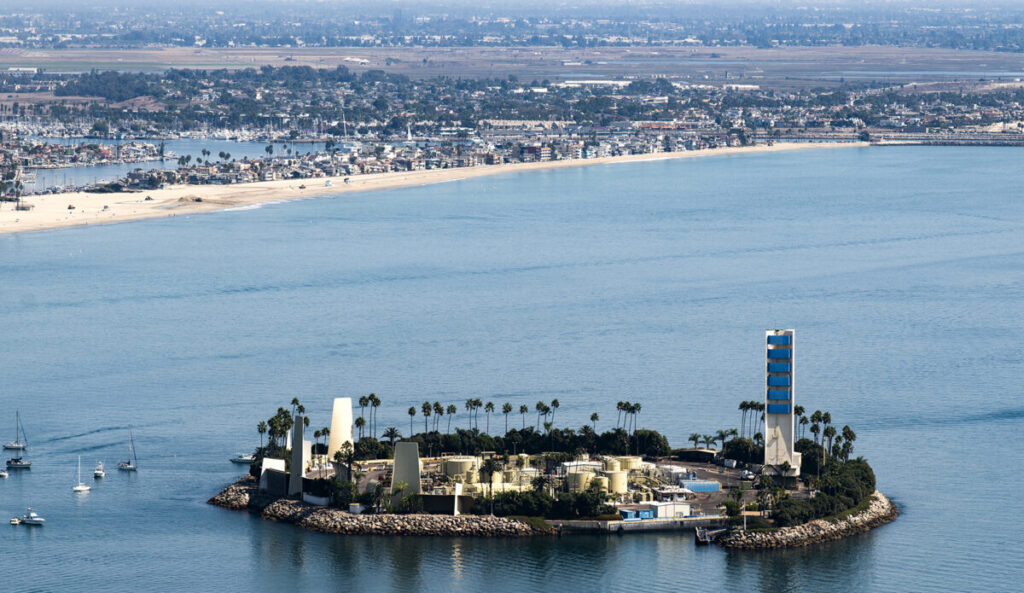Disagreement over who deserves the profits from oil being pumped out of Long Beach has pitted the city’s budget needs against the state’s and led to a flurry of lobbying as local leaders race to strike a deal.
The city has approached its state delegates with proposals on how to claim a greater share of oil revenue — which mostly goes to the state — for big-ticket items like the Belmont Shore pool and Naples seawall repair.
The city’s representatives in the state Legislature, however, say any additional money given to Long Beach will come at the cost of state priorities, like health care, homelessness and schoolchildren.
In a call this week, state Sen. Lena Gonzalez implored city leaders to face the harsh reality that “every city in her district,” as well as the state, is facing financial hardships.
“We’re not going to be able to patch all the holes that you have in the budget,” Gonzalez said.
Under the current agreement, the state takes 42.5% of oil revenue, compared to the city’s 8.5% share as the designated trustee of the land. The remaining 49% goes to the oil operator, controlled largely by the California Resources Corporation.
A reasonable share of revenue for the city, Councilmember Kristina Duggan argues, is 20% and 30%. That is one of several proposals that the mayor’s office floated, with others seeking to claim the interest off the state’s fund to eventually cap abandoned wells.
It’s the “number one lobbying issue” for the city, said Mayor Rex Richardson, as the state Legislature is set to return from its winter recess in January.
Long Beach’s budget has for decades relied on revenues from the Wilmington Oil Field, the nation’s third-largest reservoir that nets about 46,000 barrels a day.
The field goes about as far north as Ocean Boulevard, almost reaching the breakwater to the south, and encompasses some of Long Beach’s most precious assets: the beaches, marinas and Convention Center.
The city’s revenue from the field is earmarked for its Tidelands area, a 24-square-mile swath of ocean and coastline from the Orange County line through downtown Long Beach to the ports of Los Angeles and Long Beach.
For the first time, the Tidelands Fund is expected to run a deficit in 2026, with future shortfalls projected to range between $6.2 million and $10 million through 2035. This is fueled by declines in oil revenues — about $300 million over the next 10 years — and legislation that limits new oil drilling.
Losses could put at risk $1 billion in outstanding coastal projects, including a deteriorating Naples Island seawall, a long-delayed Belmont Aquatics Center and costly upgrades at the Convention Center.

But problems are not exclusive to Long Beach, Gonzalez said, citing the state’s $18 billion deficit in the most recent fiscal year. Early estimates project upwards of a $35 billion deficit next year, fueled by growing debts.
Coupled with federal cuts to health care and homelessness services, Gonzalez said the state’s wallet is under pressure from subsidizing $6 billion more for Medi-Cal losses, major clean energy projects and cuts to K-12 programs and community colleges. Telling other legislators to sacrifice those priorities for Long Beach would be a tough sell.
“What are our colleagues going to ask us? ‘Well, what are they spending the money on?’ Well, an Olympic-sized pool… Naples sea walls…,” she said. “It’s not like I’m not prioritizing this, or it doesn’t matter. It does, but how do we sell that when we’re cutting rural hospitals? How do we sell that when we’re cutting all of these other services?”
Long Beach Assemblyman Josh Lowenthal said that reopening the revenue split formula could bring “unintended consequences,” saying it could lead some state leaders to send funding into programs “that don’t serve Long Beach’s interests.”
“Our responsibility is to ensure that any action we take protects the city’s interests and those of the ultimate owners of these mineral rights — the people of California,” Lowenthal said.
The state is also well behind its obligations — about $700 million — to save up for the eventual cost to plug wells, remove derricks and restore public lands after oil operations end in 2035.
City estimates show total abandonment and decommissioning will cost $1.36 billion statewide, including $205 million for Long Beach.
Gonzalez passed legislation last year that ramped up the state’s annual savings for that future cost — from $2- to $5 million — but it’s still not expected to be enough to meet the state’s deadline.
Mayor Richardson, though, says he remains optimistic about reaching a deal, and it’s premature to say “we’ve seen resistance.”.
“All we are looking for in this moment is strong partnership with our state delegation and a willingness to work together for the needs of Long Beach,” he said.
He positioned the city’s ask as a reasonable, short-term fix. His favored plan is to siphon a small chunk of interest — $10 to $15 million annually — from the state’s fund to decommission oil fields, through 2035. By that time, Richardson explained, the city will have realized its bonanza as an entertainment hub, with a fully operational amphitheater and renovated Queen Mary, among other examples.
Without wanting to comment directly on the matter, the governor’s office said on Nov. 20 that it remains open to ongoing dialogue with the city and state legislature.

